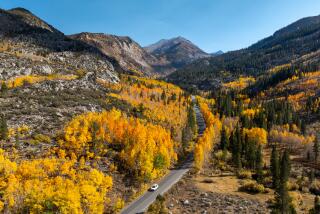Once-Neglected Anza Trail Gaining Notice as a Pathway to the Region’s Heritage
- Share via
It was February, 1776, and as revolution brewed among English colonists on the East Coast, a Spanish explorer named Juan Bautista de Anza was leading 240 settlers to establish what would become the city of San Francisco.
Despite hunger, Indian uprisings, disease and desertion, the Spanish had no time to waste, fearing the expansion of Russian colonization from the Aleutian Islands southward. The 1,200-mile trek brought Anza and the settlers from Mexico within two miles of where El Pueblo de La Reina de Los Angeles would be founded six years later. They continued through the southern San Fernando Valley and then northwest.
Although millions of Los Angeles motorists each week trace parts of the route, it has been one of the nation’s most neglected historic trails.
Today, as part of National Trails Day, local parks officials are encouraging Southland residents to drive Anza’s approximate path through Los Angeles County.
For the unadventurous, the route can be followed by taking the Pomona Freeway west to the northbound Interstate 5, and the Ventura Freeway west toward the coast.
But a countywide task force identifying Anza’s historic route has come up with a far more detailed itinerary, with 29 stops in Los Angeles County, including the Claremont Heritage Museum, La Cienega Mud Springs in San Dimas, Mission San Gabriel, Union Station in downtown Los Angeles, the La Brea Tar Pits, Mission San Fernando in Mission Hills, Tapia County Park (named after a member of Anza’s party) and Anza’s campsites in El Monte, Griffith Park and Calabasas.
Anza’s trail was traveled for six years after his party widened it from a barely discernible footpath. But it fell into disuse after Quechan Indians near what became Yuma, Ariz., perhaps sensing what was in store for their descendants, massacred a group of settlers headed north to colonize Los Angeles.
Now, as enthusiasts in 19 California and Arizona counties are reconstructing the Anza route, historians hope to fuel new interest in the region’s heritage--before and after European settlers arrived.
The proposed driving route was charted more for its scenic and historic value than as an exact overlay of Anza’s trail.
“People tend to think about Los Angeles as a new place, and they sometimes forget that there’s quite a history here,” said Ruth Kilday of the Mountains Conservancy Foundation, one of the task force coordinators. “So we tried to put together something that links up a variety of places.”
Amtrak, too, has promised to publicize the trail in literature about several of its lines that connect Yuma to the Bay Area, said Oliver Jones, project manager for Amtrak’s western routes.
Various task forces also are working on alternate routes for walking and horseback and bike riding.
During the next several months, county maps will be collated by the National Park Service, whose resources were made available for the project in 1990.
Although the Anza trail’s recent inclusion on the national list of 19 scenic and historic routes brings no cash, its new status should make it easier for local agencies to obtain federal grants to build and maintain it, said Linda Palmer, president of the Santa Monica Mountains Trails Council.
Most historic trails have been designated during the past decade--part of what many see as a new enthusiasm for such paths, especially in urban areas. In 1991, Congress approved the use of funds traditionally earmarked to highways for the enhancement of historic and scenic routes.
“People are starting to want to protect these corridors in places where the open space is disappearing,” said Meredith Kaplan, a National Park Service planner, who is working on the Anza trail. “In more rural places, it’s sometimes hard to get anyone excited about trails. But in a place like Los Angeles, they want to defend them.”
More to Read
Sign up for Essential California
The most important California stories and recommendations in your inbox every morning.
You may occasionally receive promotional content from the Los Angeles Times.













